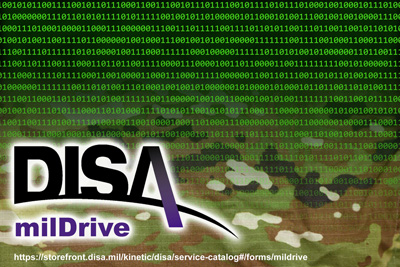By C. Todd Lopez
WASHINGTON (Jan. 23, 2020) -- The Defense Information Systems Agency has been offering "milDrive," a cloud-based storage solution for desktop users, for nearly a year.
The cloud service already has about 18,000 users across 20 organizations, the program manager said.

"There's quite a large user base in the queue right now that's interested, and we are currently piloting with and developing a migration strategy for them," said Carissa Landymore. "The need is definitely there."
The milDrive service is available for users on DODIN, the unclassified Defense Department information network.
Users often store files on network drives so they can be shared with others within their organizations. The milDrive service gives users that ability, and it also allows them to access files from any common access card-enabled computer on the network and from their government cell phones and tablets. Typically, network shared drives only allow users to access files when they are on their home network.
Unlike other cloud-service solutions in use by some DOD agencies, milDrive allows users to store files that contain personally identifiable information, personal health information and "for official use only" information because the storage for milDrive is maintained by DISA, rather than by a commercial provider, Landymore said.
"From a security perspective, all the data is always encrypted, in transit and at rest," she said. "So, it's always providing that extra blanket of security."
Also, unlike with typical network shares, milDrive users can grant access to their files to any milDrive user in the Defense Department, Landymore said. Users can even share files with other DOD personnel who don't have milDrive access through a web-based interface. And unlike some web-based cloud service solutions, milDrive is thoroughly integrated into the desktop environment, which means users can create, read and manipulate files stored in the cloud using the software already installed on their desktop computers.
"It's completely integrated and transparent on your desktop," she said. "It's the same traditional look and feel as Windows File Explorer and used like any other location to open or save files.
Landymore said DISA offers 1 terabyte or 20 gigabyte licenses for individual users. Both licenses cost less than $10 a month. Organizations can also order "team drives" starting at 1 TB. As with traditional network shares; milDrive "Team Folders" allow organizations the ability to collaborate traditionally with the added benefits of online and offline access, mobility and portability of group data they do not have today.
Guidance from the DOD chief information officer and DISA direction is going in the direction of the cloud, Landymore said. "MilDrive is going to help the department get there faster," she said. "It's going to help folks immediately migrate off their end-of-service-life equipment right onto another service that DISA is already invested into. We've made that investment to really help the department long-term, getting to a cloud solution and realizing our cost savings with economies of scale."
Jeremiah Collins, the information technology services deputy director at Army Futures Command in Austin, Texas, said milDrive has provided the command with cost savings over traditional storage solutions and a reduction in workload for a limited information technology staff.
Army Futures Command stood up in July 2018, and Collins said the command has used milDrive as its storage solution from the start.
"When we were standing up the command, we really needed a storage solution that would support a mobile workforce beyond just the installation boundaries," Collins said. "So, where teams are collaborating, no matter where they are located, they can reach back to those documents. Traditional network storage doesn't allow for that. But with milDrive, anybody that has a CAC can access it from any web browser. That was monumental in our decision to choose milDrive."
Additionally, Collins said, the low cost of storage was a deciding factor in the command's decision to go with milDrive.
"The DISA milDrive was about a third of the cost of traditional storage," Collins said. "It wasn't even close."
The cost of milDrive isn't the only way the command saves money, he said. There's also a reduction in workload by information technology support staff -- something Collins said is important in Army Futures Command, where they have both limited space and a limited staff.
"For us, we don't have the luxury of a lot of resources in our IT shop," he said. "We have to be very diligent in what we assign for tasks. With milDrive, it's simply provisioning a user to a milDrive account, which is exponentially easier for the staff here to execute based on our current resourcing thresholds."
To achieve a seamless, transparent use of milDrive, software does have to be installed on a user's computer. Until that software is installed, users can access files via a web-based application. Collins said initial use of milDrive at Army Futures Command was complicated by that requirement, but those challenges disappeared after the software was approved for use on their network.
"Quite frankly, ever since the application was installed, we've received zero complaints," Collins said.
Landymore said organizations that want to make use of milDrive can check out the services catalogue on the DISA website. In addition, she said, DISA can help organizational IT staffs migrate data on existing storage services to milDrive.